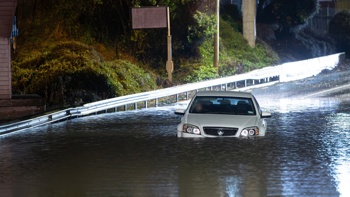A report by the Government agency Environmental Science and Research (ESR) has found there is a low risk to health from the silt deposited by the Cyclone Gabrielle flooding 17 months ago.
Silt left behind by Cyclone Gabrielle built into mountains on the devastated orchard lands and vineyards of the area. Photo / Paul Taylor.
The report was commissioned by Health New Zealand-Te Whatu Ora National Public Health Service to better understand any longer-term impacts of silt or dust on human health, with mountains of silt having been deposited across the plains, posing issues not only about what to do with it but also any problems if it remained.
Medical Officer of Health Dr Bridget Wilson said findings followed a robust study by ESR drawing on analysis from flooding events overseas, as well as in-depth local analysis on silt sampling and air quality, and officials say results are “reassuring” to communities concerned about the potential health impacts.
ESR science leader, Risk Assessment, Food and Social Systems Group, Peter Cressey, said the report concluded that “while health effects may occur due to flooding events, this is most commonly because of direct contact with flood waters, rather than flood-deposited silt.
“Communities concerned about crystalline silica in silt and the risk of silicosis can be reassured that silt contains no more crystalline silica than normal garden soil and less than most beach sand,” he said.
“Air quality monitoring in the Hawke’s Bay region during September 2023 to March 2024 also indicated a low level of concern for silicosis resulting from exposure to silt in the form of airborne dust.”
Cressey concluded long-term health risks from contact with cyclone-deposited silt are no greater than those from the day-to-day environment, adding: “Those affected by Cyclone Gabrielle have a range of huge issues to deal with. All the evidence indicates that long-term health effects due to silt will not be one of those issues.”
Dr Wilson said: “Impacted communities have been understandably concerned about the effect of silt and dust on their health and what that could mean longer term,” Dr Wilson said.
“This report was commissioned to ensure an in-depth analysis by scientists in order to provide the best possible information to support the health and wellbeing of our communities, including identifying any additional measures that may be required to further protect public health.
- Recovery taskforce 'making headway'
- Hawke's Bay businesses get $62.6m more for silt removal
- ‘A huge job’: $133m announced for silt removal in Hawke’s Bay
- Post-cyclone silt remains a lingering issue
“It is therefore extremely reassuring to share that ESR’s investigations have determined the likelihood of long-term public health impacts following silt and dust exposure is deemed low.”
Health NZ says while the results of the study on long-term health impacts are very reassuring, public health advice remained in place to support people who experienced short-term symptoms like eye and airway irritations from dust.
Wind blowing silica dust into the air in Esk Valley last September. Photo/ Warren Buckland.
“People continue to be advised to wear a mask when outside on dusty days or when undertaking clean up around their property that generates dust,” Wilson said, adding the Silt Recovery Taskforce also continued its work to minimise dust impacts.
As winds swept up dust in Esk Valley in September last year, Wilson said until more was known from air quality monitoring in affected regions, it was important for people to take precautions during times when dust was a significant issue.
It was “particularly important for the elderly, very young and people with heart or lung conditions,” she said, adding there are steps people can take to reduce the amount of dust they inhale,” she said at the time.
Take your Radio, Podcasts and Music with you









